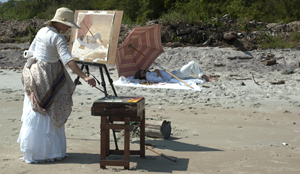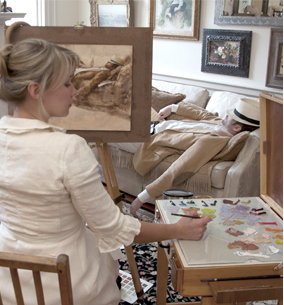
Gift Certificate

About
With this series in its beginning stages, the details regarding its description will continue to expand and evolve with time. I invite you to check back here from time to time as this series grows.
The intention with this educational collection is to explore the many facets of the creative process, share educational insights into the nuances on the art of painting, and offer a combination of both sophisticated information for the experienced artist, as well as foundational explorations in light and color, which I refer to as ‘delights.’ Primarily directed toward a younger audience as a way to invite them into the beautiful world ofthe Arts, these ‘delights’ will often be told in storybook
form, and will serve as a wonderful resource for parents to share with their little ones. I have been creating these stories and educational exercises for my nephew and nieces, and I am excited to share them with you and your family.
I hope you will enjoy this new series. I will continue to create it with the same loving care, and hold it to a high standard of excellence, as I did with my first educational offering, ‘Learning with Richard Schmid.’ Lesson credits will work the same, and be interchangeable between both series.
I look forward to growing and learning with you.
About
WITH THESE LESSONS:
- Follow along with Richard, stroke-by-stroke, as he paints a variety of subjects including the still life, landscape and figure.
- Study the surface quality and paint application at each stage of the demonstrations, including the finished pieces, by zooming-in on the images with the zoom tool, or by viewing them in full screen mode.
- Learn to simplify what you are seeing into manageable shapes of color, each with their appropriate value, color, and edges.
- Discover the color combinations, how he mixes paint, and the techniques Richard uses to bring visual form to an idea.
- Learn how to paint from life and the benefits of continued study from Nature.
- See how a painting can be taken from a field sketch to a completed painting.
- Understand the factors to consider when working from photographs, and learn how to effectively paint from them.
“IN PAINTING, ALWAYS REMEMBER THAT WHATEVER YOU ARE LOOKING AT ALWAYS COMES DOWN TO NOTES OF COLOR RATHER THAN THINGS LIKE LEAVES, GRASS, AND SKY.”— Richard Schmid
A NOTE FROM THE AUTHOR
 Richard is a continuation in the lineage of the great artists from the Romantic era, a direct descendant of a generation rooted in centuries of knowledge, which culminated in a very high level of aesthetic sophistication. Richard’s philosophy stems from a time when beauty was found, even in tragedy, and the most cherished and revered art was always an ascending act which served as an affirmation of joy and solace to sorrow.
Richard is a continuation in the lineage of the great artists from the Romantic era, a direct descendant of a generation rooted in centuries of knowledge, which culminated in a very high level of aesthetic sophistication. Richard’s philosophy stems from a time when beauty was found, even in tragedy, and the most cherished and revered art was always an ascending act which served as an affirmation of joy and solace to sorrow.
Rarely does an artist of Richard’s caliber come along. Even more scarce are those who can articulate how it is they do what they do, and who are generous enough to share their discoveries with others. Richard is a unique combination of virtuoso skill and an unmatched ability to clearly communicate how he employs the use of paint to express what he sees. This series was inspired by a desire to preserve his teachings and the knowledge he has cultivated over the 60+ years he has so passionately dedicated to painting. May the ideas presented here nurture your creative endeavors and provide opportunities to explore new worlds within this field of expression.
—With gratitude, Katie Swatland
“Katie Swatland’s presentation of our instructional sessions brings an insight and animation into my teaching that is impossible for me to achieve. This is because she speaks from the experience of one who is learning, whereas I can only speak from the perspective of one who already knows.
Thus it is that Katie presents the ideas I offer with a unique clarity. When I give critiques she anticipates the questions in her readers’ minds because they are her questions too. When the stages of my demonstration paintings are shown, Katie can explain and analyze them because she watched them happen. Her personal thoughts and observations connect with readers and vividly recreate the experience of being there.”
—Richard Schmid

